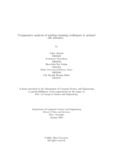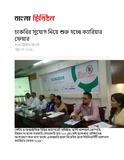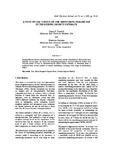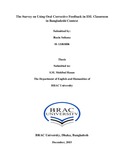Comparative analysis of machine learning techniques in optimal site selection
Date
2023-01Publisher
Brac UniversityAuthor
Aurnab, AukikChoudhury, Shaktiman
Ruhan, Shoubhick Roy
Rifaiya Abrar, Shikh Muhammad
Hossain Rabbi, S.M. Riyadh
Metadata
Show full item recordAbstract
Site selection is a crucial aspect of many businesses, as a company’s location can sig nificantly impact its success. In recent years, machine learning techniques have been
increasingly used to assist with optimal site selection by providing data-driven pre dictions about the potential success of a given location. Machine learning techniques
can be used to assist in the process of selecting the optimal site by analyzing the
patterns in data such as demographics, lifestyle services, and geographic features.
In this paper, we compare several machine learning techniques for their perfor mance in optimal site selection for features extracted from Open Street Map (OSM)
data, WorldPop population data, and Bing satellite imagery. A target dataset cor responding to the features extracted was collected from Yelp data on restaurant
check-ins, and this was used as a parameter to determine the human engagement
rate of that location with the businesses in that area. Our analysis methods in cluded SVR, Random Forest, XGBoost, Ridge Regression, Lasso Regression, and
ElasticNet. The satellite imagery collected from Bing maps were used to train CNN
architectures such as; VGG16, VGG19, ResNet, DenseNet, and InceptionV3 and the
results were compared. We evaluated the techniques using several metrics, including
Root Mean Squared Error (RMSE), Mean Squared Error (MSE), Mean Absolute
Error (MAE), Median Absolute Error(MedAE), Max Error(ME), and Median Abso lute Deviation(MAD). We used algorithm and strategies that performed the best in
related works for this research. One meta model was also implemented in this work
by an ensemble learning technique known as stacking. The model that performed
the best for the data collected was then determined by looking at the error scores of
different models. This work provides an insight into the strengths and limitations
of each technique and recommendations for practitioners considering the use of ma chine learning in site selection. This study demonstrates the potential of machine
learning for improving site selection processes and highlights the importance of con sidering multiple approaches.
Keywords
Optimal Site Selection (OSS); Comparative analysis; Boosting and stacking; SVR; Random forest; XGBoost; Ridge regression; Lasso regression; Elasticnet; Convolutional Neural Network (CNN); Ensemble learning; VGG16; VGG19; ResNet; DenseNet; InceptionV3; Root Mean Squared Error (RMSE); Mean Squared Error (MSE); Mean Absolute Error (MAE); Median Absolute Error (MedAE); Max error (ME); Median Absolute Deviation(MAD)Description
This thesis is submitted in partial fulfillment of the requirements for the degree of Bachelor of Science in Computer Science and Engineering, 2023.Department
Department of Computer Science and Engineering, Brac UniversityType
ThesisCollections
Related items
Showing items related by title, author, creator and subject.
-
Error analysis in EFL writing classroom
Karim, Abdul; Mohamed, Abdul R.; Ismail, Shaik A. M. M.; Shahed, Faheem H.; Rahman, Mohammad Mosiur; Haque, Md. Hamidul (© 2018 Canadian Center of Science and Education, 2018-03-22)Identifying the EFL learners’ errors in writing has no longer been important but essential. As such, drawing the pertinent questions that what are the most common types of error committed by EFL learners in Bangladesh ... -
A note on the choice of the smoothing parameter in the kernel dinsity estimate
Froelich, Daniel F.; Rahman, Mezbahur (BRAC University, 2009)Among different density estimation procedures, the kernel density estimation has attracted the most attention. In this paper, the choices for smoothing parameter is discussed when the widely used Gaussian kernel is used ... -
The survey on using oral corrective feedback in ESL classroom in Bangladeshi context
Sultana, Razia (BRAC University, 2015-12)Feedback plays a significant role for all the level of students to improve their second language learning. Although, there are various types of feedback, this study will focus only oral corrective feedback. The purpose ...




